Report on Financial Economics: Bank Profitability Analysis
VerifiedAdded on 2020/04/15
|23
|6033
|58
Report
AI Summary
This report examines the determinants of profitability for both state-owned and joint-stock Chinese commercial banks following the global economic crisis (GFC). The analysis categorizes determinants into internal factors (bank-specific, such as asset composition, capital adequacy, and operational efficiency) and external factors (macroeconomic environment and industry structure). The study employs principal component analysis and data envelopment analysis to assess profitability, focusing on metrics like ROA, ROE, and NIM. It explores the impact of bank size, cost-to-income ratio, capital adequacy, and non-performing loans, along with macroeconomic variables like inflation and GDP. The research highlights the importance of internal factors, including management quality and corporate governance, while also considering external influences on bank performance. The report concludes by synthesizing these factors to provide insights into the financial health and operational efficiency of Chinese commercial banks.
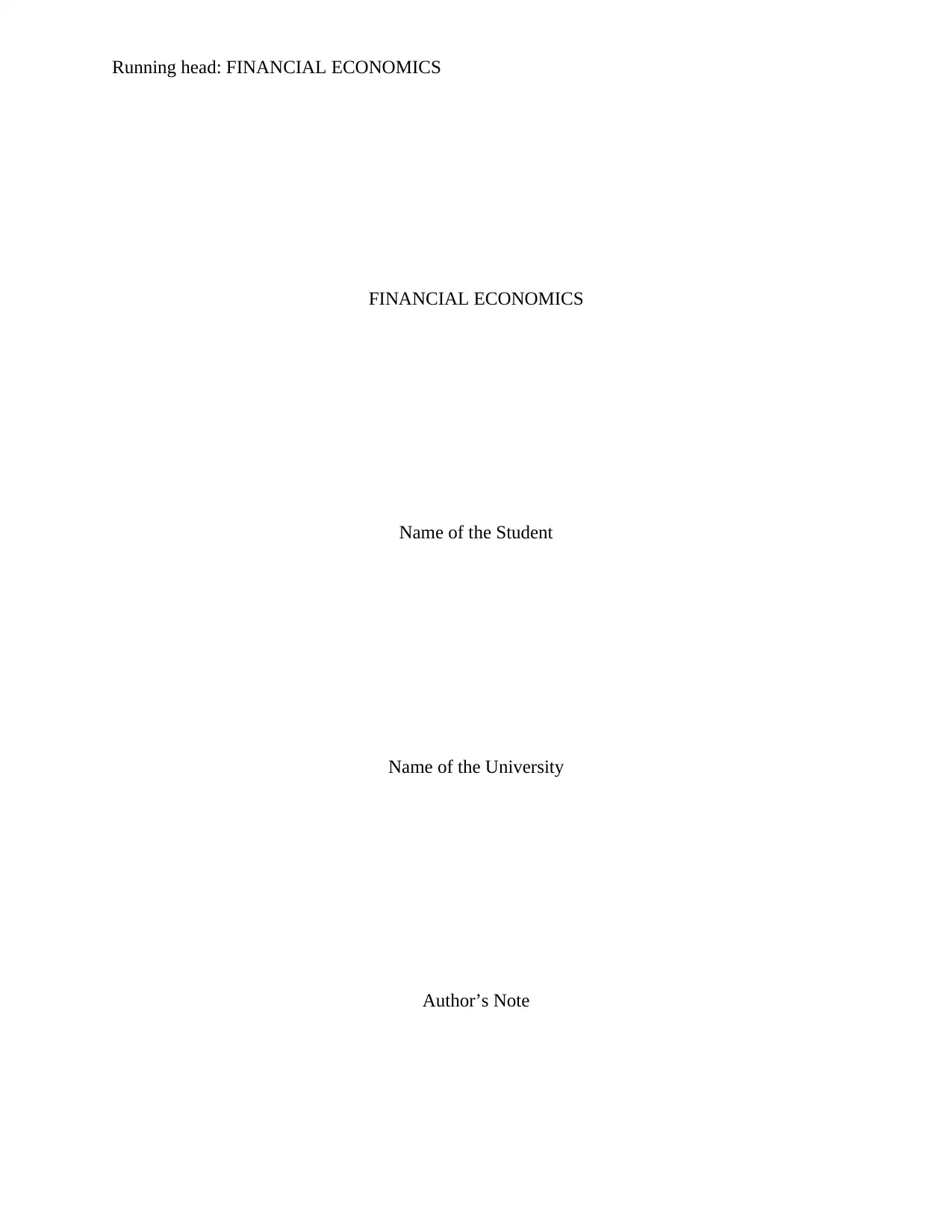
Running head: FINANCIAL ECONOMICS
FINANCIAL ECONOMICS
Name of the Student
Name of the University
Author’s Note
FINANCIAL ECONOMICS
Name of the Student
Name of the University
Author’s Note
Paraphrase This Document
Need a fresh take? Get an instant paraphrase of this document with our AI Paraphraser
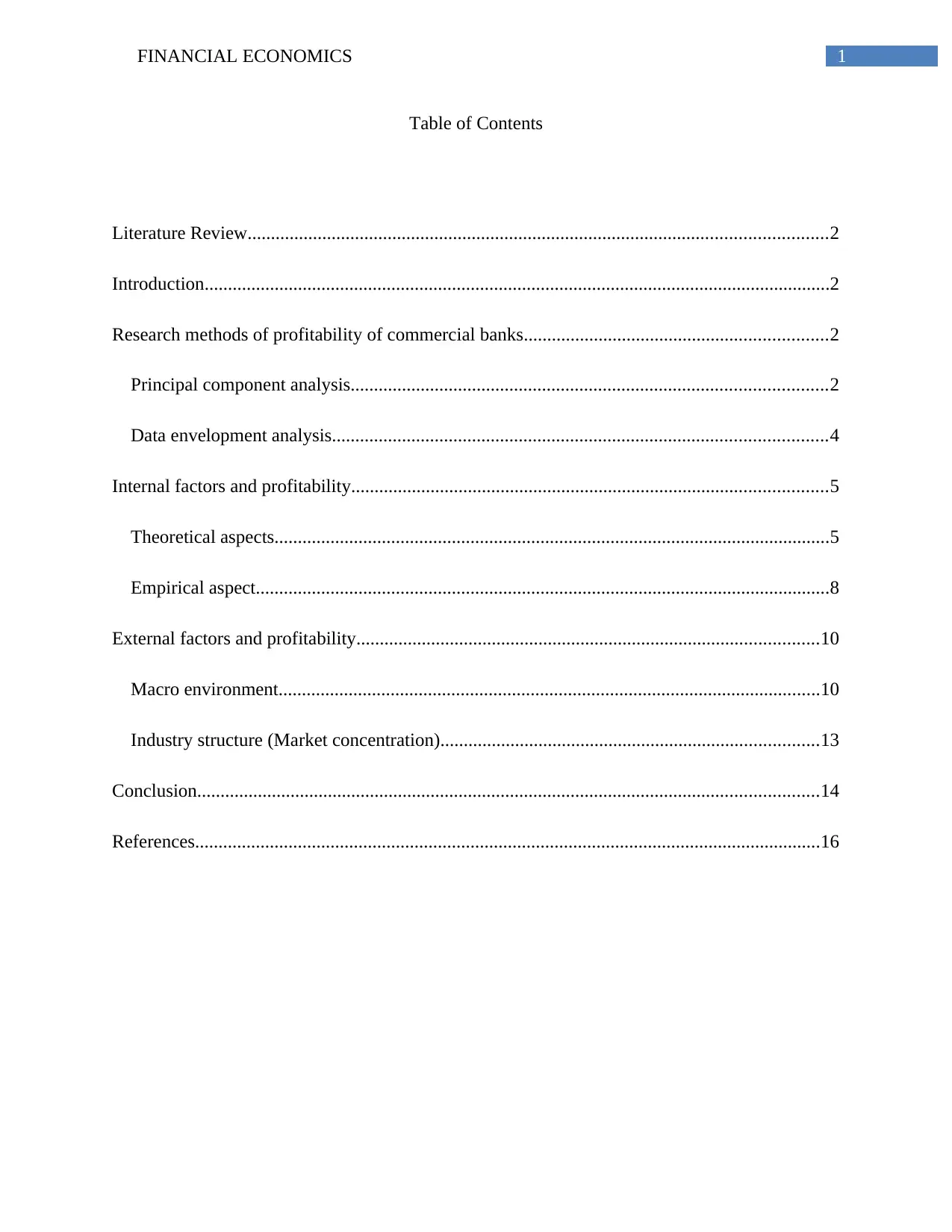
1FINANCIAL ECONOMICS
Table of Contents
Literature Review............................................................................................................................2
Introduction......................................................................................................................................2
Research methods of profitability of commercial banks.................................................................2
Principal component analysis......................................................................................................2
Data envelopment analysis..........................................................................................................4
Internal factors and profitability......................................................................................................5
Theoretical aspects.......................................................................................................................5
Empirical aspect...........................................................................................................................8
External factors and profitability...................................................................................................10
Macro environment....................................................................................................................10
Industry structure (Market concentration).................................................................................13
Conclusion.....................................................................................................................................14
References......................................................................................................................................16
Table of Contents
Literature Review............................................................................................................................2
Introduction......................................................................................................................................2
Research methods of profitability of commercial banks.................................................................2
Principal component analysis......................................................................................................2
Data envelopment analysis..........................................................................................................4
Internal factors and profitability......................................................................................................5
Theoretical aspects.......................................................................................................................5
Empirical aspect...........................................................................................................................8
External factors and profitability...................................................................................................10
Macro environment....................................................................................................................10
Industry structure (Market concentration).................................................................................13
Conclusion.....................................................................................................................................14
References......................................................................................................................................16
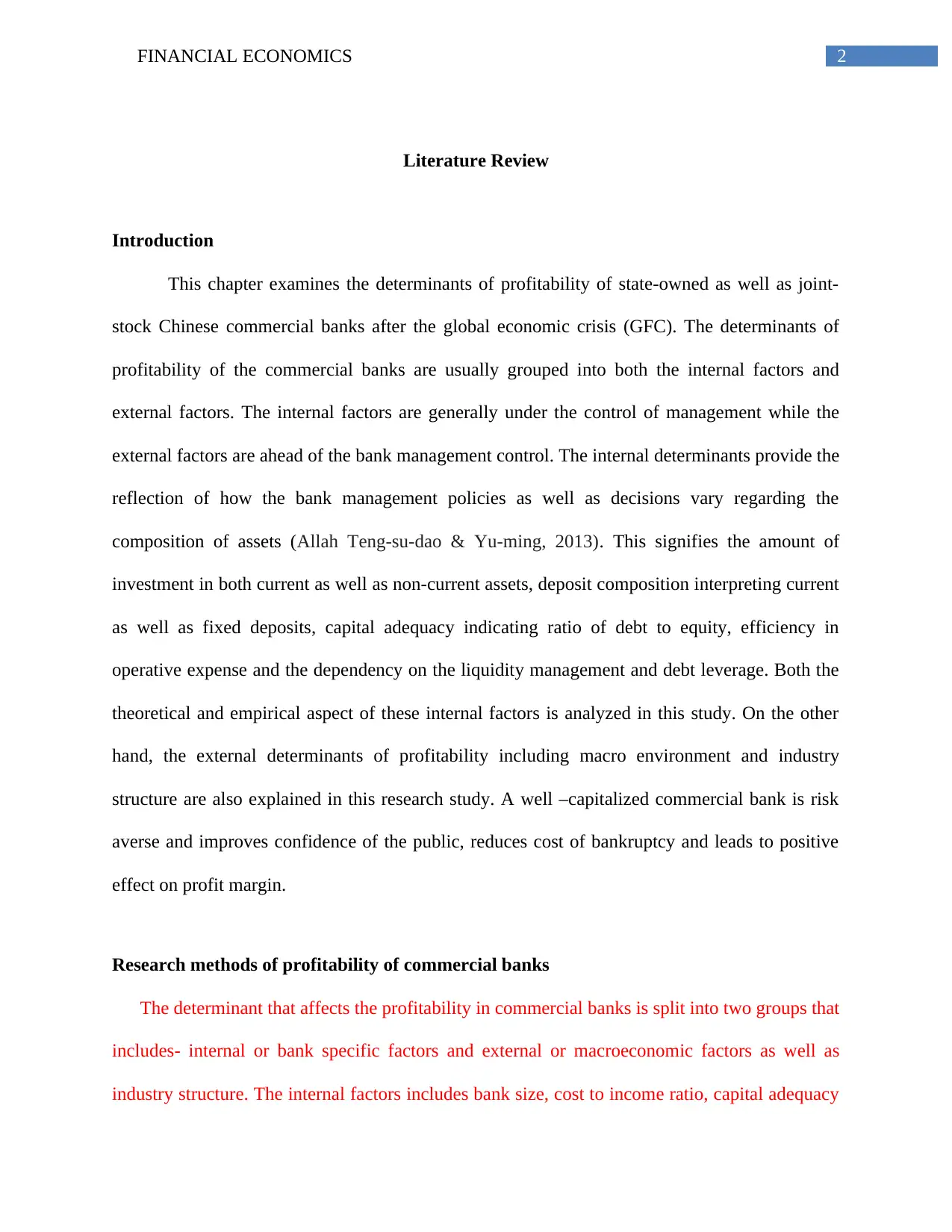
2FINANCIAL ECONOMICS
Literature Review
Introduction
This chapter examines the determinants of profitability of state-owned as well as joint-
stock Chinese commercial banks after the global economic crisis (GFC). The determinants of
profitability of the commercial banks are usually grouped into both the internal factors and
external factors. The internal factors are generally under the control of management while the
external factors are ahead of the bank management control. The internal determinants provide the
reflection of how the bank management policies as well as decisions vary regarding the
composition of assets (Allah Teng-su-dao & Yu-ming, 2013). This signifies the amount of
investment in both current as well as non-current assets, deposit composition interpreting current
as well as fixed deposits, capital adequacy indicating ratio of debt to equity, efficiency in
operative expense and the dependency on the liquidity management and debt leverage. Both the
theoretical and empirical aspect of these internal factors is analyzed in this study. On the other
hand, the external determinants of profitability including macro environment and industry
structure are also explained in this research study. A well –capitalized commercial bank is risk
averse and improves confidence of the public, reduces cost of bankruptcy and leads to positive
effect on profit margin.
Research methods of profitability of commercial banks
The determinant that affects the profitability in commercial banks is split into two groups that
includes- internal or bank specific factors and external or macroeconomic factors as well as
industry structure. The internal factors includes bank size, cost to income ratio, capital adequacy
Literature Review
Introduction
This chapter examines the determinants of profitability of state-owned as well as joint-
stock Chinese commercial banks after the global economic crisis (GFC). The determinants of
profitability of the commercial banks are usually grouped into both the internal factors and
external factors. The internal factors are generally under the control of management while the
external factors are ahead of the bank management control. The internal determinants provide the
reflection of how the bank management policies as well as decisions vary regarding the
composition of assets (Allah Teng-su-dao & Yu-ming, 2013). This signifies the amount of
investment in both current as well as non-current assets, deposit composition interpreting current
as well as fixed deposits, capital adequacy indicating ratio of debt to equity, efficiency in
operative expense and the dependency on the liquidity management and debt leverage. Both the
theoretical and empirical aspect of these internal factors is analyzed in this study. On the other
hand, the external determinants of profitability including macro environment and industry
structure are also explained in this research study. A well –capitalized commercial bank is risk
averse and improves confidence of the public, reduces cost of bankruptcy and leads to positive
effect on profit margin.
Research methods of profitability of commercial banks
The determinant that affects the profitability in commercial banks is split into two groups that
includes- internal or bank specific factors and external or macroeconomic factors as well as
industry structure. The internal factors includes bank size, cost to income ratio, capital adequacy
⊘ This is a preview!⊘
Do you want full access?
Subscribe today to unlock all pages.

Trusted by 1+ million students worldwide
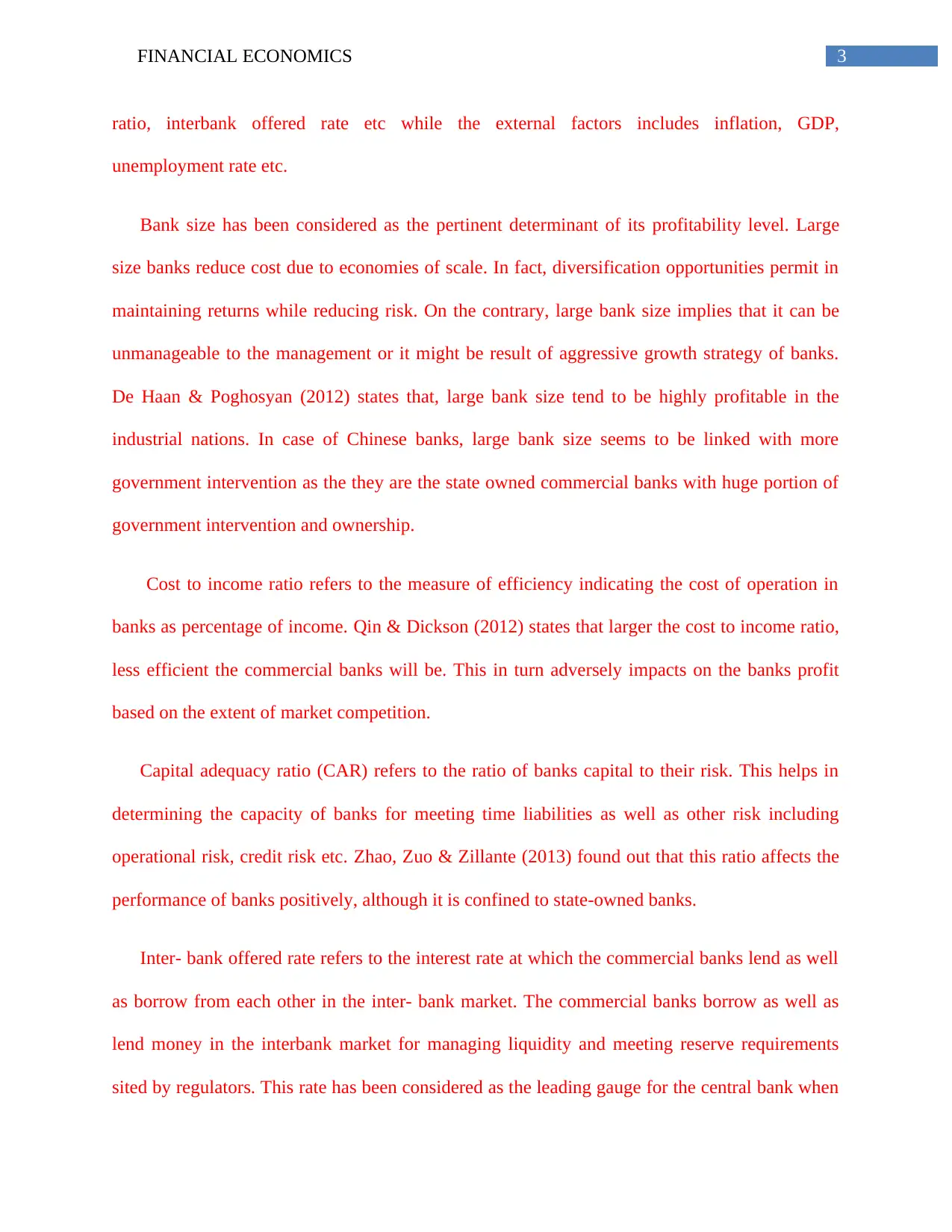
3FINANCIAL ECONOMICS
ratio, interbank offered rate etc while the external factors includes inflation, GDP,
unemployment rate etc.
Bank size has been considered as the pertinent determinant of its profitability level. Large
size banks reduce cost due to economies of scale. In fact, diversification opportunities permit in
maintaining returns while reducing risk. On the contrary, large bank size implies that it can be
unmanageable to the management or it might be result of aggressive growth strategy of banks.
De Haan & Poghosyan (2012) states that, large bank size tend to be highly profitable in the
industrial nations. In case of Chinese banks, large bank size seems to be linked with more
government intervention as the they are the state owned commercial banks with huge portion of
government intervention and ownership.
Cost to income ratio refers to the measure of efficiency indicating the cost of operation in
banks as percentage of income. Qin & Dickson (2012) states that larger the cost to income ratio,
less efficient the commercial banks will be. This in turn adversely impacts on the banks profit
based on the extent of market competition.
Capital adequacy ratio (CAR) refers to the ratio of banks capital to their risk. This helps in
determining the capacity of banks for meeting time liabilities as well as other risk including
operational risk, credit risk etc. Zhao, Zuo & Zillante (2013) found out that this ratio affects the
performance of banks positively, although it is confined to state-owned banks.
Inter- bank offered rate refers to the interest rate at which the commercial banks lend as well
as borrow from each other in the inter- bank market. The commercial banks borrow as well as
lend money in the interbank market for managing liquidity and meeting reserve requirements
sited by regulators. This rate has been considered as the leading gauge for the central bank when
ratio, interbank offered rate etc while the external factors includes inflation, GDP,
unemployment rate etc.
Bank size has been considered as the pertinent determinant of its profitability level. Large
size banks reduce cost due to economies of scale. In fact, diversification opportunities permit in
maintaining returns while reducing risk. On the contrary, large bank size implies that it can be
unmanageable to the management or it might be result of aggressive growth strategy of banks.
De Haan & Poghosyan (2012) states that, large bank size tend to be highly profitable in the
industrial nations. In case of Chinese banks, large bank size seems to be linked with more
government intervention as the they are the state owned commercial banks with huge portion of
government intervention and ownership.
Cost to income ratio refers to the measure of efficiency indicating the cost of operation in
banks as percentage of income. Qin & Dickson (2012) states that larger the cost to income ratio,
less efficient the commercial banks will be. This in turn adversely impacts on the banks profit
based on the extent of market competition.
Capital adequacy ratio (CAR) refers to the ratio of banks capital to their risk. This helps in
determining the capacity of banks for meeting time liabilities as well as other risk including
operational risk, credit risk etc. Zhao, Zuo & Zillante (2013) found out that this ratio affects the
performance of banks positively, although it is confined to state-owned banks.
Inter- bank offered rate refers to the interest rate at which the commercial banks lend as well
as borrow from each other in the inter- bank market. The commercial banks borrow as well as
lend money in the interbank market for managing liquidity and meeting reserve requirements
sited by regulators. This rate has been considered as the leading gauge for the central bank when
Paraphrase This Document
Need a fresh take? Get an instant paraphrase of this document with our AI Paraphraser
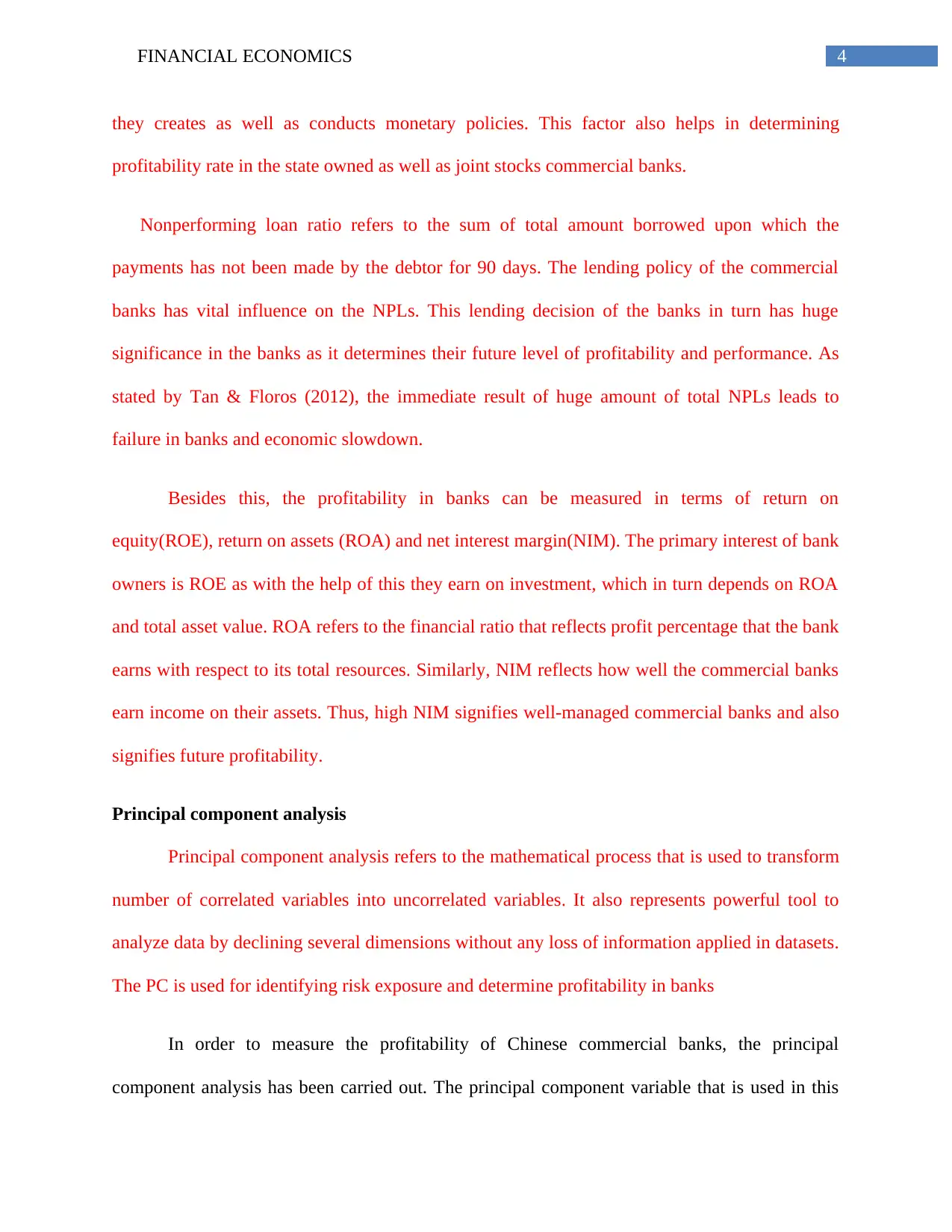
4FINANCIAL ECONOMICS
they creates as well as conducts monetary policies. This factor also helps in determining
profitability rate in the state owned as well as joint stocks commercial banks.
Nonperforming loan ratio refers to the sum of total amount borrowed upon which the
payments has not been made by the debtor for 90 days. The lending policy of the commercial
banks has vital influence on the NPLs. This lending decision of the banks in turn has huge
significance in the banks as it determines their future level of profitability and performance. As
stated by Tan & Floros (2012), the immediate result of huge amount of total NPLs leads to
failure in banks and economic slowdown.
Besides this, the profitability in banks can be measured in terms of return on
equity(ROE), return on assets (ROA) and net interest margin(NIM). The primary interest of bank
owners is ROE as with the help of this they earn on investment, which in turn depends on ROA
and total asset value. ROA refers to the financial ratio that reflects profit percentage that the bank
earns with respect to its total resources. Similarly, NIM reflects how well the commercial banks
earn income on their assets. Thus, high NIM signifies well-managed commercial banks and also
signifies future profitability.
Principal component analysis
Principal component analysis refers to the mathematical process that is used to transform
number of correlated variables into uncorrelated variables. It also represents powerful tool to
analyze data by declining several dimensions without any loss of information applied in datasets.
The PC is used for identifying risk exposure and determine profitability in banks
In order to measure the profitability of Chinese commercial banks, the principal
component analysis has been carried out. The principal component variable that is used in this
they creates as well as conducts monetary policies. This factor also helps in determining
profitability rate in the state owned as well as joint stocks commercial banks.
Nonperforming loan ratio refers to the sum of total amount borrowed upon which the
payments has not been made by the debtor for 90 days. The lending policy of the commercial
banks has vital influence on the NPLs. This lending decision of the banks in turn has huge
significance in the banks as it determines their future level of profitability and performance. As
stated by Tan & Floros (2012), the immediate result of huge amount of total NPLs leads to
failure in banks and economic slowdown.
Besides this, the profitability in banks can be measured in terms of return on
equity(ROE), return on assets (ROA) and net interest margin(NIM). The primary interest of bank
owners is ROE as with the help of this they earn on investment, which in turn depends on ROA
and total asset value. ROA refers to the financial ratio that reflects profit percentage that the bank
earns with respect to its total resources. Similarly, NIM reflects how well the commercial banks
earn income on their assets. Thus, high NIM signifies well-managed commercial banks and also
signifies future profitability.
Principal component analysis
Principal component analysis refers to the mathematical process that is used to transform
number of correlated variables into uncorrelated variables. It also represents powerful tool to
analyze data by declining several dimensions without any loss of information applied in datasets.
The PC is used for identifying risk exposure and determine profitability in banks
In order to measure the profitability of Chinese commercial banks, the principal
component analysis has been carried out. The principal component variable that is used in this
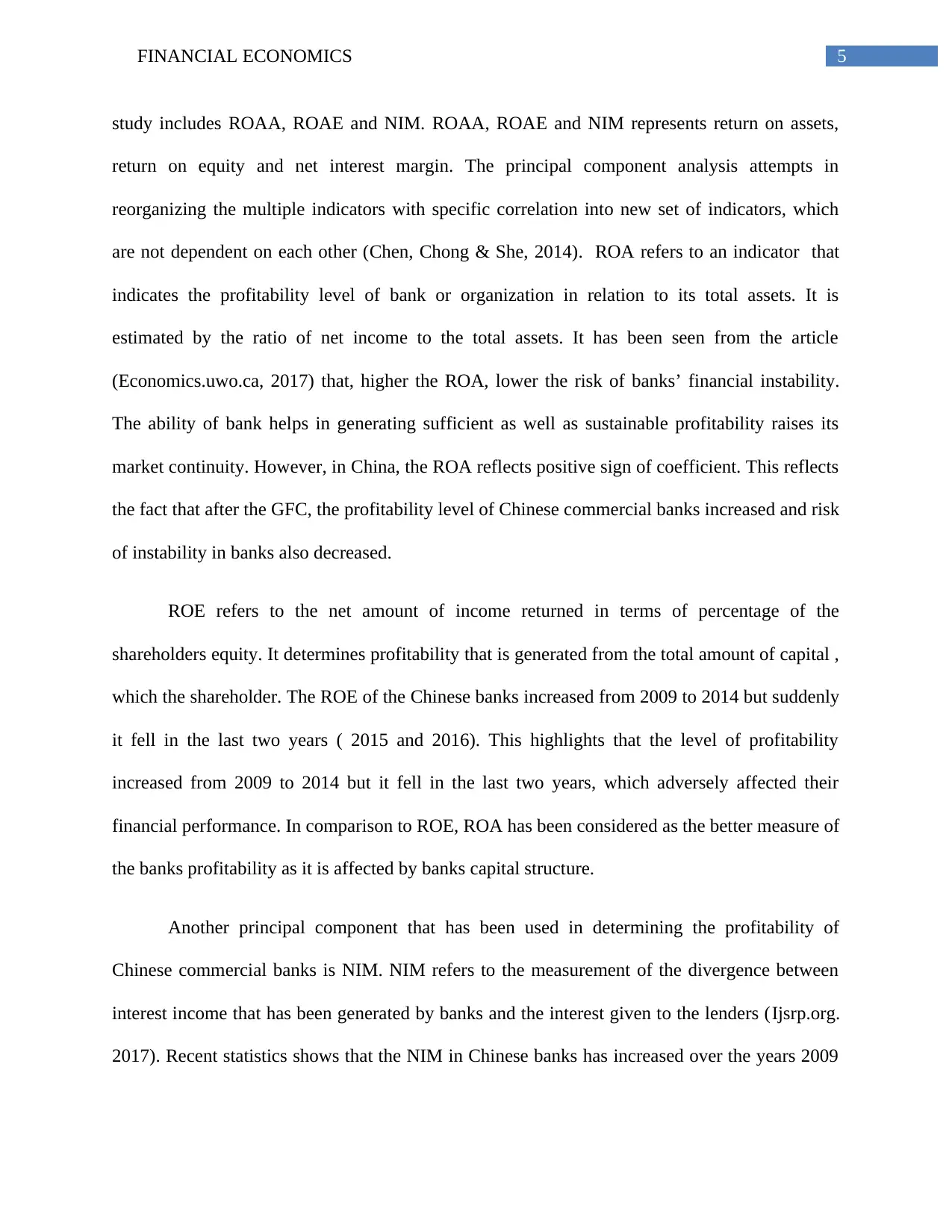
5FINANCIAL ECONOMICS
study includes ROAA, ROAE and NIM. ROAA, ROAE and NIM represents return on assets,
return on equity and net interest margin. The principal component analysis attempts in
reorganizing the multiple indicators with specific correlation into new set of indicators, which
are not dependent on each other (Chen, Chong & She, 2014). ROA refers to an indicator that
indicates the profitability level of bank or organization in relation to its total assets. It is
estimated by the ratio of net income to the total assets. It has been seen from the article
(Economics.uwo.ca, 2017) that, higher the ROA, lower the risk of banks’ financial instability.
The ability of bank helps in generating sufficient as well as sustainable profitability raises its
market continuity. However, in China, the ROA reflects positive sign of coefficient. This reflects
the fact that after the GFC, the profitability level of Chinese commercial banks increased and risk
of instability in banks also decreased.
ROE refers to the net amount of income returned in terms of percentage of the
shareholders equity. It determines profitability that is generated from the total amount of capital ,
which the shareholder. The ROE of the Chinese banks increased from 2009 to 2014 but suddenly
it fell in the last two years ( 2015 and 2016). This highlights that the level of profitability
increased from 2009 to 2014 but it fell in the last two years, which adversely affected their
financial performance. In comparison to ROE, ROA has been considered as the better measure of
the banks profitability as it is affected by banks capital structure.
Another principal component that has been used in determining the profitability of
Chinese commercial banks is NIM. NIM refers to the measurement of the divergence between
interest income that has been generated by banks and the interest given to the lenders (Ijsrp.org.
2017). Recent statistics shows that the NIM in Chinese banks has increased over the years 2009
study includes ROAA, ROAE and NIM. ROAA, ROAE and NIM represents return on assets,
return on equity and net interest margin. The principal component analysis attempts in
reorganizing the multiple indicators with specific correlation into new set of indicators, which
are not dependent on each other (Chen, Chong & She, 2014). ROA refers to an indicator that
indicates the profitability level of bank or organization in relation to its total assets. It is
estimated by the ratio of net income to the total assets. It has been seen from the article
(Economics.uwo.ca, 2017) that, higher the ROA, lower the risk of banks’ financial instability.
The ability of bank helps in generating sufficient as well as sustainable profitability raises its
market continuity. However, in China, the ROA reflects positive sign of coefficient. This reflects
the fact that after the GFC, the profitability level of Chinese commercial banks increased and risk
of instability in banks also decreased.
ROE refers to the net amount of income returned in terms of percentage of the
shareholders equity. It determines profitability that is generated from the total amount of capital ,
which the shareholder. The ROE of the Chinese banks increased from 2009 to 2014 but suddenly
it fell in the last two years ( 2015 and 2016). This highlights that the level of profitability
increased from 2009 to 2014 but it fell in the last two years, which adversely affected their
financial performance. In comparison to ROE, ROA has been considered as the better measure of
the banks profitability as it is affected by banks capital structure.
Another principal component that has been used in determining the profitability of
Chinese commercial banks is NIM. NIM refers to the measurement of the divergence between
interest income that has been generated by banks and the interest given to the lenders (Ijsrp.org.
2017). Recent statistics shows that the NIM in Chinese banks has increased over the years 2009
⊘ This is a preview!⊘
Do you want full access?
Subscribe today to unlock all pages.

Trusted by 1+ million students worldwide
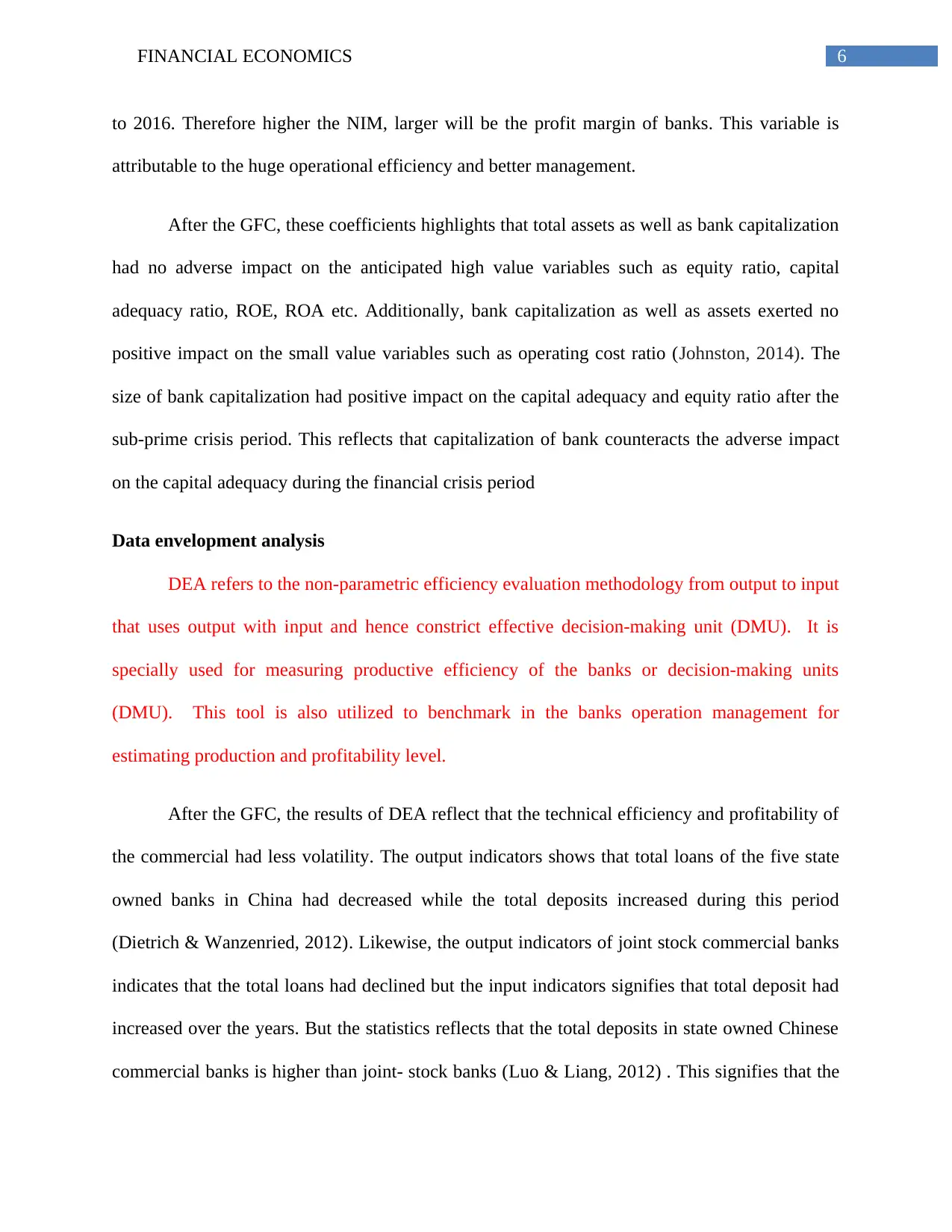
6FINANCIAL ECONOMICS
to 2016. Therefore higher the NIM, larger will be the profit margin of banks. This variable is
attributable to the huge operational efficiency and better management.
After the GFC, these coefficients highlights that total assets as well as bank capitalization
had no adverse impact on the anticipated high value variables such as equity ratio, capital
adequacy ratio, ROE, ROA etc. Additionally, bank capitalization as well as assets exerted no
positive impact on the small value variables such as operating cost ratio (Johnston, 2014). The
size of bank capitalization had positive impact on the capital adequacy and equity ratio after the
sub-prime crisis period. This reflects that capitalization of bank counteracts the adverse impact
on the capital adequacy during the financial crisis period
Data envelopment analysis
DEA refers to the non-parametric efficiency evaluation methodology from output to input
that uses output with input and hence constrict effective decision-making unit (DMU). It is
specially used for measuring productive efficiency of the banks or decision-making units
(DMU). This tool is also utilized to benchmark in the banks operation management for
estimating production and profitability level.
After the GFC, the results of DEA reflect that the technical efficiency and profitability of
the commercial had less volatility. The output indicators shows that total loans of the five state
owned banks in China had decreased while the total deposits increased during this period
(Dietrich & Wanzenried, 2012). Likewise, the output indicators of joint stock commercial banks
indicates that the total loans had declined but the input indicators signifies that total deposit had
increased over the years. But the statistics reflects that the total deposits in state owned Chinese
commercial banks is higher than joint- stock banks (Luo & Liang, 2012) . This signifies that the
to 2016. Therefore higher the NIM, larger will be the profit margin of banks. This variable is
attributable to the huge operational efficiency and better management.
After the GFC, these coefficients highlights that total assets as well as bank capitalization
had no adverse impact on the anticipated high value variables such as equity ratio, capital
adequacy ratio, ROE, ROA etc. Additionally, bank capitalization as well as assets exerted no
positive impact on the small value variables such as operating cost ratio (Johnston, 2014). The
size of bank capitalization had positive impact on the capital adequacy and equity ratio after the
sub-prime crisis period. This reflects that capitalization of bank counteracts the adverse impact
on the capital adequacy during the financial crisis period
Data envelopment analysis
DEA refers to the non-parametric efficiency evaluation methodology from output to input
that uses output with input and hence constrict effective decision-making unit (DMU). It is
specially used for measuring productive efficiency of the banks or decision-making units
(DMU). This tool is also utilized to benchmark in the banks operation management for
estimating production and profitability level.
After the GFC, the results of DEA reflect that the technical efficiency and profitability of
the commercial had less volatility. The output indicators shows that total loans of the five state
owned banks in China had decreased while the total deposits increased during this period
(Dietrich & Wanzenried, 2012). Likewise, the output indicators of joint stock commercial banks
indicates that the total loans had declined but the input indicators signifies that total deposit had
increased over the years. But the statistics reflects that the total deposits in state owned Chinese
commercial banks is higher than joint- stock banks (Luo & Liang, 2012) . This signifies that the
Paraphrase This Document
Need a fresh take? Get an instant paraphrase of this document with our AI Paraphraser
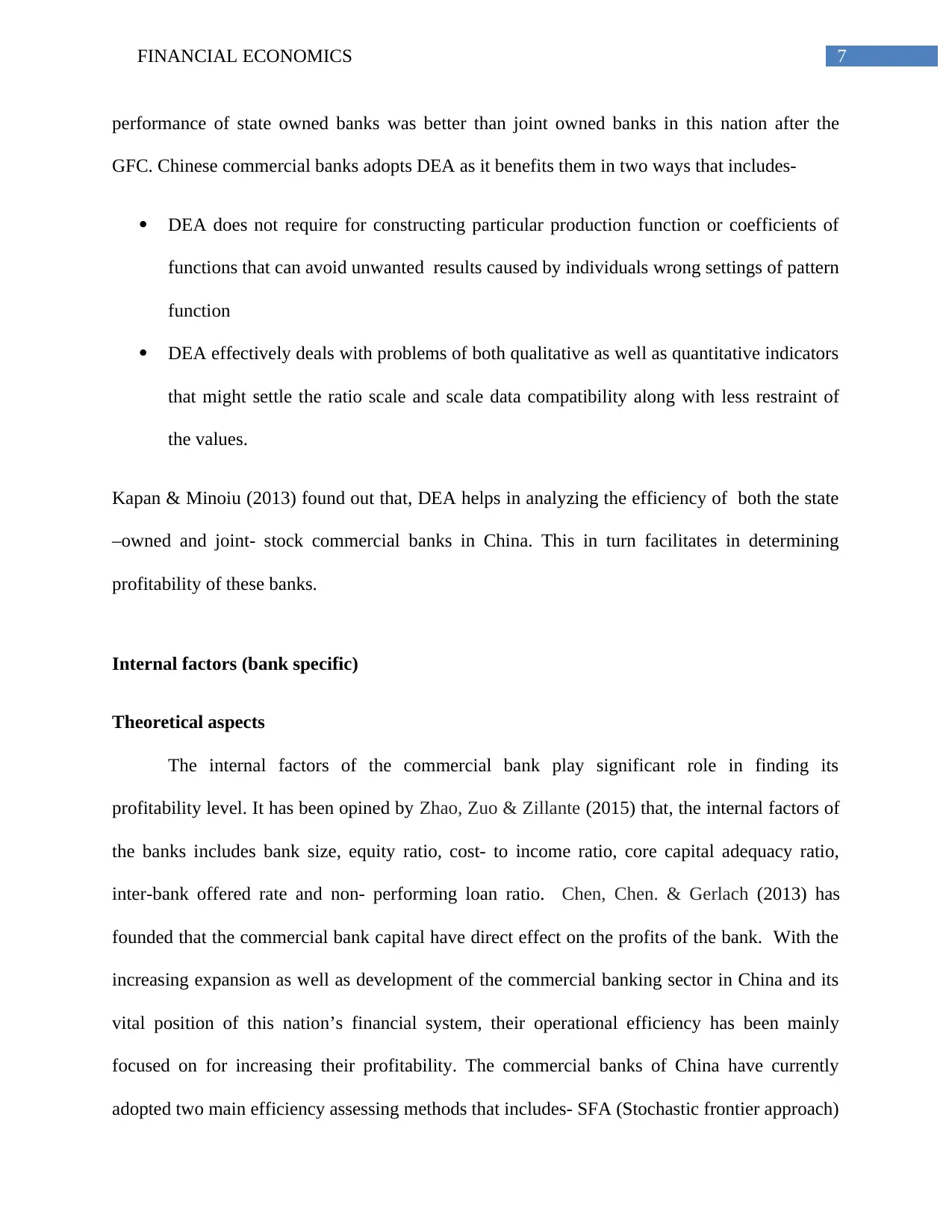
7FINANCIAL ECONOMICS
performance of state owned banks was better than joint owned banks in this nation after the
GFC. Chinese commercial banks adopts DEA as it benefits them in two ways that includes-
DEA does not require for constructing particular production function or coefficients of
functions that can avoid unwanted results caused by individuals wrong settings of pattern
function
DEA effectively deals with problems of both qualitative as well as quantitative indicators
that might settle the ratio scale and scale data compatibility along with less restraint of
the values.
Kapan & Minoiu (2013) found out that, DEA helps in analyzing the efficiency of both the state
–owned and joint- stock commercial banks in China. This in turn facilitates in determining
profitability of these banks.
Internal factors (bank specific)
Theoretical aspects
The internal factors of the commercial bank play significant role in finding its
profitability level. It has been opined by Zhao, Zuo & Zillante (2015) that, the internal factors of
the banks includes bank size, equity ratio, cost- to income ratio, core capital adequacy ratio,
inter-bank offered rate and non- performing loan ratio. Chen, Chen. & Gerlach (2013) has
founded that the commercial bank capital have direct effect on the profits of the bank. With the
increasing expansion as well as development of the commercial banking sector in China and its
vital position of this nation’s financial system, their operational efficiency has been mainly
focused on for increasing their profitability. The commercial banks of China have currently
adopted two main efficiency assessing methods that includes- SFA (Stochastic frontier approach)
performance of state owned banks was better than joint owned banks in this nation after the
GFC. Chinese commercial banks adopts DEA as it benefits them in two ways that includes-
DEA does not require for constructing particular production function or coefficients of
functions that can avoid unwanted results caused by individuals wrong settings of pattern
function
DEA effectively deals with problems of both qualitative as well as quantitative indicators
that might settle the ratio scale and scale data compatibility along with less restraint of
the values.
Kapan & Minoiu (2013) found out that, DEA helps in analyzing the efficiency of both the state
–owned and joint- stock commercial banks in China. This in turn facilitates in determining
profitability of these banks.
Internal factors (bank specific)
Theoretical aspects
The internal factors of the commercial bank play significant role in finding its
profitability level. It has been opined by Zhao, Zuo & Zillante (2015) that, the internal factors of
the banks includes bank size, equity ratio, cost- to income ratio, core capital adequacy ratio,
inter-bank offered rate and non- performing loan ratio. Chen, Chen. & Gerlach (2013) has
founded that the commercial bank capital have direct effect on the profits of the bank. With the
increasing expansion as well as development of the commercial banking sector in China and its
vital position of this nation’s financial system, their operational efficiency has been mainly
focused on for increasing their profitability. The commercial banks of China have currently
adopted two main efficiency assessing methods that includes- SFA (Stochastic frontier approach)
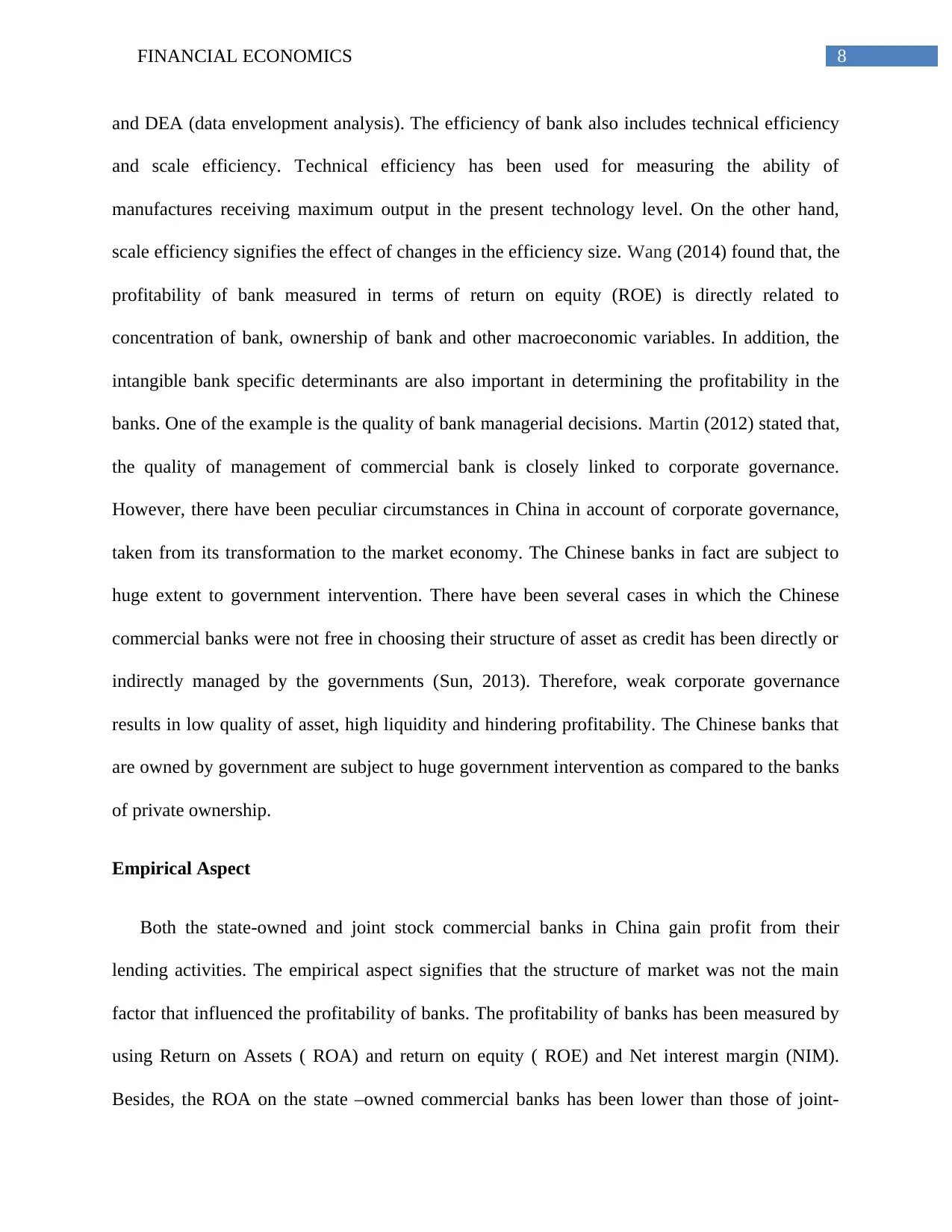
8FINANCIAL ECONOMICS
and DEA (data envelopment analysis). The efficiency of bank also includes technical efficiency
and scale efficiency. Technical efficiency has been used for measuring the ability of
manufactures receiving maximum output in the present technology level. On the other hand,
scale efficiency signifies the effect of changes in the efficiency size. Wang (2014) found that, the
profitability of bank measured in terms of return on equity (ROE) is directly related to
concentration of bank, ownership of bank and other macroeconomic variables. In addition, the
intangible bank specific determinants are also important in determining the profitability in the
banks. One of the example is the quality of bank managerial decisions. Martin (2012) stated that,
the quality of management of commercial bank is closely linked to corporate governance.
However, there have been peculiar circumstances in China in account of corporate governance,
taken from its transformation to the market economy. The Chinese banks in fact are subject to
huge extent to government intervention. There have been several cases in which the Chinese
commercial banks were not free in choosing their structure of asset as credit has been directly or
indirectly managed by the governments (Sun, 2013). Therefore, weak corporate governance
results in low quality of asset, high liquidity and hindering profitability. The Chinese banks that
are owned by government are subject to huge government intervention as compared to the banks
of private ownership.
Empirical Aspect
Both the state-owned and joint stock commercial banks in China gain profit from their
lending activities. The empirical aspect signifies that the structure of market was not the main
factor that influenced the profitability of banks. The profitability of banks has been measured by
using Return on Assets ( ROA) and return on equity ( ROE) and Net interest margin (NIM).
Besides, the ROA on the state –owned commercial banks has been lower than those of joint-
and DEA (data envelopment analysis). The efficiency of bank also includes technical efficiency
and scale efficiency. Technical efficiency has been used for measuring the ability of
manufactures receiving maximum output in the present technology level. On the other hand,
scale efficiency signifies the effect of changes in the efficiency size. Wang (2014) found that, the
profitability of bank measured in terms of return on equity (ROE) is directly related to
concentration of bank, ownership of bank and other macroeconomic variables. In addition, the
intangible bank specific determinants are also important in determining the profitability in the
banks. One of the example is the quality of bank managerial decisions. Martin (2012) stated that,
the quality of management of commercial bank is closely linked to corporate governance.
However, there have been peculiar circumstances in China in account of corporate governance,
taken from its transformation to the market economy. The Chinese banks in fact are subject to
huge extent to government intervention. There have been several cases in which the Chinese
commercial banks were not free in choosing their structure of asset as credit has been directly or
indirectly managed by the governments (Sun, 2013). Therefore, weak corporate governance
results in low quality of asset, high liquidity and hindering profitability. The Chinese banks that
are owned by government are subject to huge government intervention as compared to the banks
of private ownership.
Empirical Aspect
Both the state-owned and joint stock commercial banks in China gain profit from their
lending activities. The empirical aspect signifies that the structure of market was not the main
factor that influenced the profitability of banks. The profitability of banks has been measured by
using Return on Assets ( ROA) and return on equity ( ROE) and Net interest margin (NIM).
Besides, the ROA on the state –owned commercial banks has been lower than those of joint-
⊘ This is a preview!⊘
Do you want full access?
Subscribe today to unlock all pages.

Trusted by 1+ million students worldwide
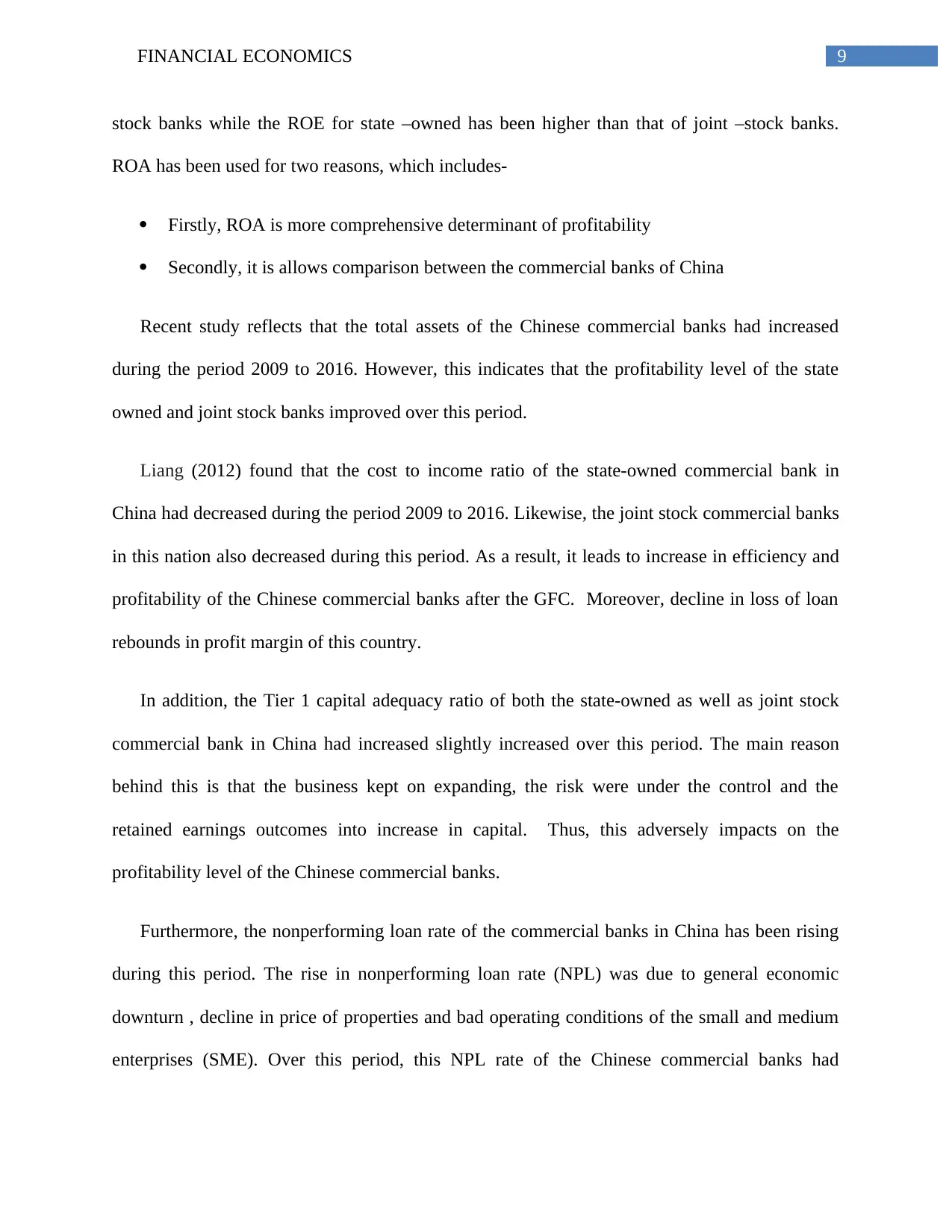
9FINANCIAL ECONOMICS
stock banks while the ROE for state –owned has been higher than that of joint –stock banks.
ROA has been used for two reasons, which includes-
Firstly, ROA is more comprehensive determinant of profitability
Secondly, it is allows comparison between the commercial banks of China
Recent study reflects that the total assets of the Chinese commercial banks had increased
during the period 2009 to 2016. However, this indicates that the profitability level of the state
owned and joint stock banks improved over this period.
Liang (2012) found that the cost to income ratio of the state-owned commercial bank in
China had decreased during the period 2009 to 2016. Likewise, the joint stock commercial banks
in this nation also decreased during this period. As a result, it leads to increase in efficiency and
profitability of the Chinese commercial banks after the GFC. Moreover, decline in loss of loan
rebounds in profit margin of this country.
In addition, the Tier 1 capital adequacy ratio of both the state-owned as well as joint stock
commercial bank in China had increased slightly increased over this period. The main reason
behind this is that the business kept on expanding, the risk were under the control and the
retained earnings outcomes into increase in capital. Thus, this adversely impacts on the
profitability level of the Chinese commercial banks.
Furthermore, the nonperforming loan rate of the commercial banks in China has been rising
during this period. The rise in nonperforming loan rate (NPL) was due to general economic
downturn , decline in price of properties and bad operating conditions of the small and medium
enterprises (SME). Over this period, this NPL rate of the Chinese commercial banks had
stock banks while the ROE for state –owned has been higher than that of joint –stock banks.
ROA has been used for two reasons, which includes-
Firstly, ROA is more comprehensive determinant of profitability
Secondly, it is allows comparison between the commercial banks of China
Recent study reflects that the total assets of the Chinese commercial banks had increased
during the period 2009 to 2016. However, this indicates that the profitability level of the state
owned and joint stock banks improved over this period.
Liang (2012) found that the cost to income ratio of the state-owned commercial bank in
China had decreased during the period 2009 to 2016. Likewise, the joint stock commercial banks
in this nation also decreased during this period. As a result, it leads to increase in efficiency and
profitability of the Chinese commercial banks after the GFC. Moreover, decline in loss of loan
rebounds in profit margin of this country.
In addition, the Tier 1 capital adequacy ratio of both the state-owned as well as joint stock
commercial bank in China had increased slightly increased over this period. The main reason
behind this is that the business kept on expanding, the risk were under the control and the
retained earnings outcomes into increase in capital. Thus, this adversely impacts on the
profitability level of the Chinese commercial banks.
Furthermore, the nonperforming loan rate of the commercial banks in China has been rising
during this period. The rise in nonperforming loan rate (NPL) was due to general economic
downturn , decline in price of properties and bad operating conditions of the small and medium
enterprises (SME). Over this period, this NPL rate of the Chinese commercial banks had
Paraphrase This Document
Need a fresh take? Get an instant paraphrase of this document with our AI Paraphraser
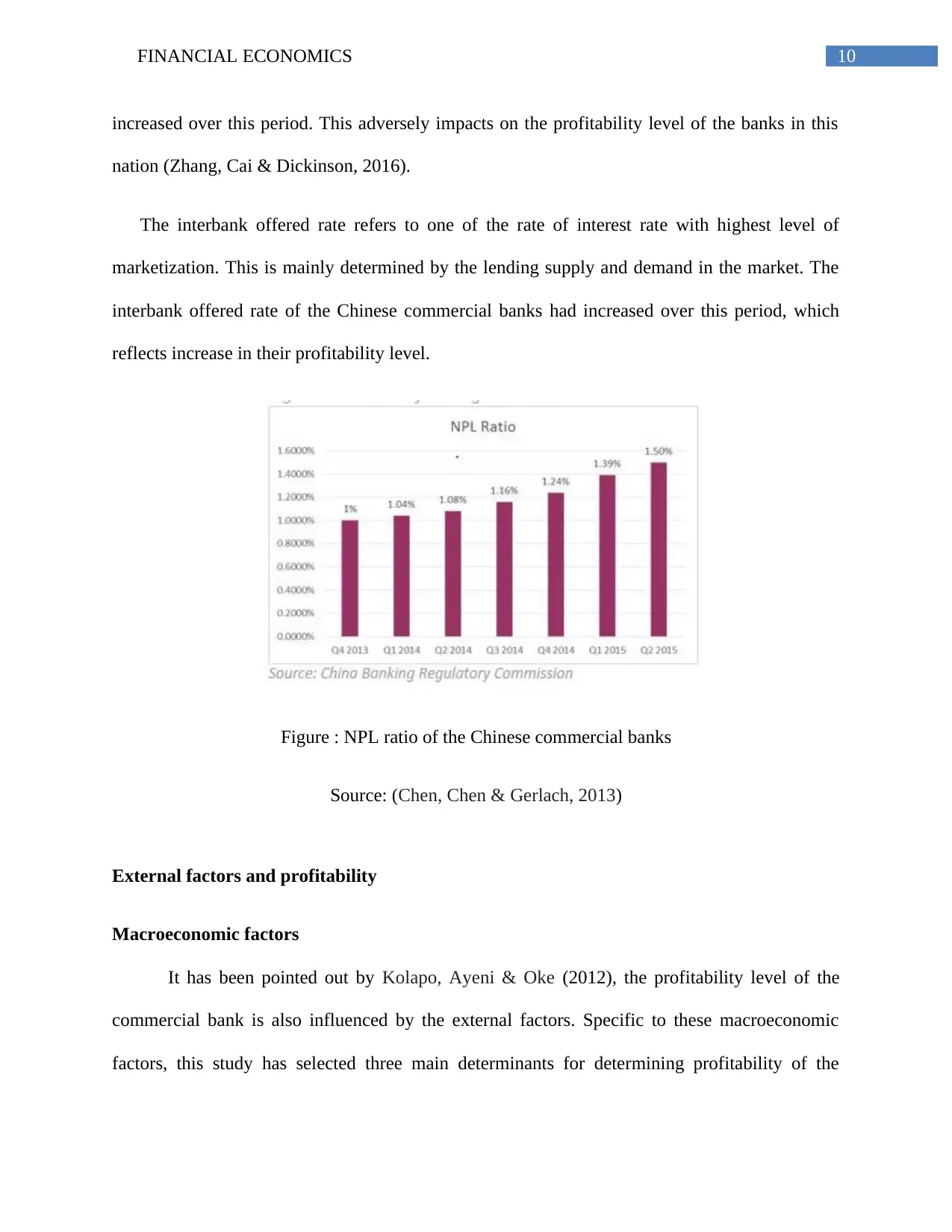
10FINANCIAL ECONOMICS
increased over this period. This adversely impacts on the profitability level of the banks in this
nation (Zhang, Cai & Dickinson, 2016).
The interbank offered rate refers to one of the rate of interest rate with highest level of
marketization. This is mainly determined by the lending supply and demand in the market. The
interbank offered rate of the Chinese commercial banks had increased over this period, which
reflects increase in their profitability level.
Figure : NPL ratio of the Chinese commercial banks
Source: (Chen, Chen & Gerlach, 2013)
External factors and profitability
Macroeconomic factors
It has been pointed out by Kolapo, Ayeni & Oke (2012), the profitability level of the
commercial bank is also influenced by the external factors. Specific to these macroeconomic
factors, this study has selected three main determinants for determining profitability of the
increased over this period. This adversely impacts on the profitability level of the banks in this
nation (Zhang, Cai & Dickinson, 2016).
The interbank offered rate refers to one of the rate of interest rate with highest level of
marketization. This is mainly determined by the lending supply and demand in the market. The
interbank offered rate of the Chinese commercial banks had increased over this period, which
reflects increase in their profitability level.
Figure : NPL ratio of the Chinese commercial banks
Source: (Chen, Chen & Gerlach, 2013)
External factors and profitability
Macroeconomic factors
It has been pointed out by Kolapo, Ayeni & Oke (2012), the profitability level of the
commercial bank is also influenced by the external factors. Specific to these macroeconomic
factors, this study has selected three main determinants for determining profitability of the
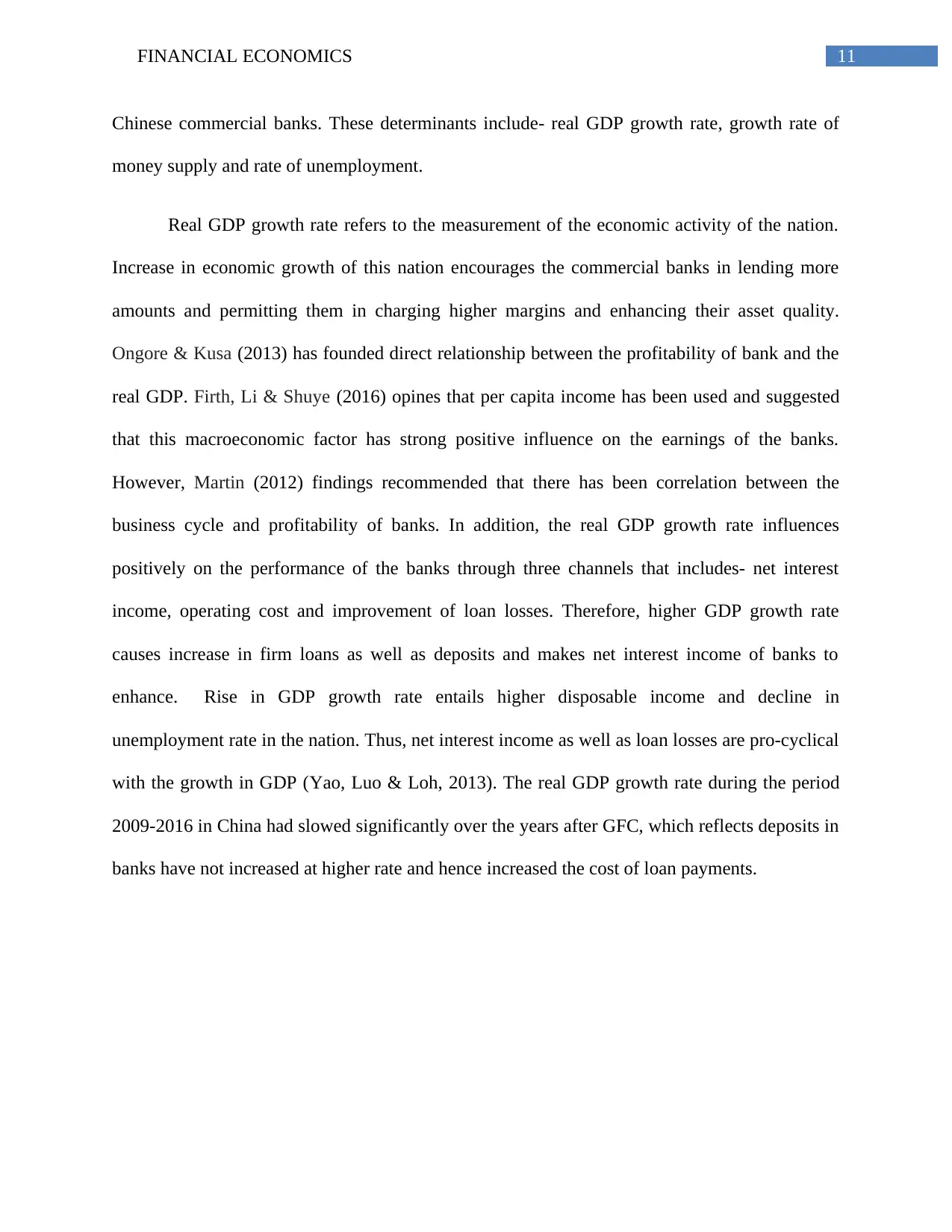
11FINANCIAL ECONOMICS
Chinese commercial banks. These determinants include- real GDP growth rate, growth rate of
money supply and rate of unemployment.
Real GDP growth rate refers to the measurement of the economic activity of the nation.
Increase in economic growth of this nation encourages the commercial banks in lending more
amounts and permitting them in charging higher margins and enhancing their asset quality.
Ongore & Kusa (2013) has founded direct relationship between the profitability of bank and the
real GDP. Firth, Li & Shuye (2016) opines that per capita income has been used and suggested
that this macroeconomic factor has strong positive influence on the earnings of the banks.
However, Martin (2012) findings recommended that there has been correlation between the
business cycle and profitability of banks. In addition, the real GDP growth rate influences
positively on the performance of the banks through three channels that includes- net interest
income, operating cost and improvement of loan losses. Therefore, higher GDP growth rate
causes increase in firm loans as well as deposits and makes net interest income of banks to
enhance. Rise in GDP growth rate entails higher disposable income and decline in
unemployment rate in the nation. Thus, net interest income as well as loan losses are pro-cyclical
with the growth in GDP (Yao, Luo & Loh, 2013). The real GDP growth rate during the period
2009-2016 in China had slowed significantly over the years after GFC, which reflects deposits in
banks have not increased at higher rate and hence increased the cost of loan payments.
Chinese commercial banks. These determinants include- real GDP growth rate, growth rate of
money supply and rate of unemployment.
Real GDP growth rate refers to the measurement of the economic activity of the nation.
Increase in economic growth of this nation encourages the commercial banks in lending more
amounts and permitting them in charging higher margins and enhancing their asset quality.
Ongore & Kusa (2013) has founded direct relationship between the profitability of bank and the
real GDP. Firth, Li & Shuye (2016) opines that per capita income has been used and suggested
that this macroeconomic factor has strong positive influence on the earnings of the banks.
However, Martin (2012) findings recommended that there has been correlation between the
business cycle and profitability of banks. In addition, the real GDP growth rate influences
positively on the performance of the banks through three channels that includes- net interest
income, operating cost and improvement of loan losses. Therefore, higher GDP growth rate
causes increase in firm loans as well as deposits and makes net interest income of banks to
enhance. Rise in GDP growth rate entails higher disposable income and decline in
unemployment rate in the nation. Thus, net interest income as well as loan losses are pro-cyclical
with the growth in GDP (Yao, Luo & Loh, 2013). The real GDP growth rate during the period
2009-2016 in China had slowed significantly over the years after GFC, which reflects deposits in
banks have not increased at higher rate and hence increased the cost of loan payments.
⊘ This is a preview!⊘
Do you want full access?
Subscribe today to unlock all pages.

Trusted by 1+ million students worldwide
1 out of 23
Related Documents
Your All-in-One AI-Powered Toolkit for Academic Success.
+13062052269
info@desklib.com
Available 24*7 on WhatsApp / Email
![[object Object]](/_next/static/media/star-bottom.7253800d.svg)
Unlock your academic potential
Copyright © 2020–2025 A2Z Services. All Rights Reserved. Developed and managed by ZUCOL.




